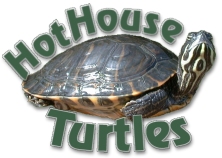OUTDOOR TURTLE PONDS
POND MINIMUM SIZE AND DEPTH
Ponds must be deep enough for your Turtle to swim freely, and not able to reach the
surface by standing on the bottom. Preformed fiberglass or plastic ponds are ideal. These
are readily available from specialist Pet Shops, Garden Centres or Landscape Supply
outlets. Constructing a pond using heavy duty pond liners will also work. Ideal
depth would be 35 - 45cm. Concrete ponds, if constructed, must be as smooth as possible
otherwise the underneath shell of the Turtle will get abrasions from dragging on the pond
surface. This could in turn lead to infection resulting in shell rot. Personally I do not
recommend using concrete.
A ramp must be constructed to enable your Turtle to leave
the water to sun.
Do not keep Turtles in a pond that is too shallow, they
will heat up and cool down to frequently!!!
POND POSITION
Try and position your pond facing north. This will attract the most sun. Provide an area
for sunning, and provide some shade for your Turtle to move out of the sun when it gets to
hot.
FENCING YOUR POND
Your pond must be fenced to prevent your Turtle from wandering off. Turtles are good
climbers, so make sure that your fence is at least 40cm high. Don't have your fence made
of shade cloth or wire mesh. Don't have rocks or shrubs close to your fence. Your Turtle
will simply climb these and go walk about. If your Turtle can see through it's fence then
it will spend most of the time trying to get through or over. We have used half-rounds, or
plywood. Both of these must be H3 treated to prevent rotting over time. Also by placing a
capping or over hang on top facing in will certainly prevent escapes. If you are worried
about Dogs, then by constructing a strong mesh top will place your mind at ease.
MINIMUM SIZE OF TURTLES FOR OUTSIDE LIVING
Hatchling Turtles will not survive if placed outside from a young age. We work on a
minimum shell length of 12 - 15cm. Any smaller and the Turtles survival rate is low.
TIME OF YEAR TO INTRODUCE TO OUTSIDE LIVING
This is imperative that this is adhered to in order for your Turtle to survive it's first
winter of outside life, and every winter thereafter. Move your Turtle into it's pond
between the last week of November and mid December. This will allow your Turtle to
experience the days getting longer to the longest day and then the season changes as we
move into autumn.
FEEDING, WHEN TO STOP AND START
Feed your Turtle once daily. Stop feeding your Turtle mid April and resume feeding mid to
late October. As the weather cools into autumn you will notice your Turtle will look for
less food. They must empty their stomach contents before they hibernate. If they don't,
any undigested food will rot inside them and they will die. Remember, your Turtle has a
built in clock for this, and may even refuse food before mid April. Don't panic about
this, just keep an eye on your Turtle, and if you are concerned for it's health consult a
Vet for a check up, or set up it's indoor home for the winter months and try again next
summer.
WATER QUALITY
I recommend that the water undergo a complete change every week or two depending on the
amount and size of Turtles, size of pond, and whether or not you have been heavy handed
with the feeding.
WATER FILTRATION
There is no need to have a filtration system in your pond. This decision is entirely over
to you.
HEATING
There is no need to heat the water.
HIBERNATION
Turtles hibernate in the water. They will move around a little and may even come out to
sun on sunny winter days. This is normal behavior. If your Turtle is not returning to the
water often, or not at all, especially when the sun goes down, then it is advised to
re-setup the indoor heated tank for the winter and try again next Summer. Not all Turtles
adjust the first time round.
You can not successfully hibernate Turtles inside
in their tank. It is simply not cold enough, and your Turtle will die from attempting
this!!!
Back to Indoor Turtle Environment
|



